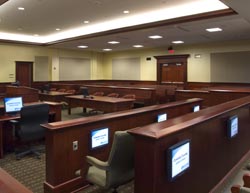- NEWNAN, GA-Judges and their clerks now serve as a central hub for digital information in the courtrooms of Georgia's new $35 million Coweta County Justice Center. The decision to build the new facility was made when the county outgrew the single courtroom in its historic brick courthouse. Now court is in session at the 120,000-square-foot judicial complex, which opened last summer.
Each courtroom in the Coweta County Justice Center is equipped with LCD video displays, though attorneys can also use a portable projector for large-screen presentations.
Members of the judicial staff led the charge for an AV evolution. In particular, chief magistrate Judge Jim Stripling relied on his personal interest in audio recording and technology when members of the court began meeting with Atlanta-based audiovisual consultant EDI.
"We came from a one-room courthouse with a PA system in it," Stripling explained, adding that most of the judges in Coweta County had practiced law in many high-tech courtrooms and knew what types of equipment and services they were looking for in their new courthouse.
First on the docket for the modification of the AV design was remote arraignment. The original plan was to outfit some of the courtrooms for videoconferencing, but by the time construction began, the judges were very interested in enabling video arraignment, especially in the magistrate courts, where arraignments are a major function every day. The Coweta County jail is only a couple of miles away from the courthouse, but the enhanced security provided by remote arraignment, along with the savings in transportation and personnel costs, prompted the construction of a remote courthouse facility in the jail. "We ended up adding video arraignment for each of the courtrooms in the main building," recalled David McLaughlin, account manager at AVI's Atlanta office.
Video arraignment proceedings are recorded onto DVD, and electronic signatures are captured with an Interlink signature pad. Vaddio video cameras offered a tremendous infrastructure benefit. "Vaddio's cameras use Cat-5 cabling for the control, the video, and power," McLaughlin said, "so it becomes more of a nice, clean installation with Cat-5 cabling replacing a video cable, a power cable, and a control cable."
The cameras are controlled via the judges' and clerks' Crestron touch panels, which also serve as video displays for those positions in the courtroom. When the button for video arraignment is pressed, the cameras move to preset positions for that procedure.
The output for all the video sources in the courtrooms consists of LCD video displays. NEC 17-inch monitors were selected for counsel desks and for the court reporters, while 15-inch displays were installed in the jury boxes. Motorized projection screens were installed in the ceiling of each courtroom, but aesthetics as well as the judge's desire for more control over the display of video content made a portable projector the appropriate solution.
Annotation was another technology that the judges were eager to add to the system, so a 17-inch Elo touch panel was used at the witness stand, and a Crestron DTT18 18-inch touch panel was selected for the bench and the clerk's desk.
With so many video displays and so much content and annotation flowing around the courtroom via Extron routers and scalers, the control interface was a significant piece of the system. AVI and EDI met with courthouse personnel numerous times to perfect the numerous interfaces. The result was a multi-faceted approach to control.
Attorneys have simple push-button interfaces to submit evidence to the judge, who then distributes it to the other screens in the courtroom. The lectern touch panel allows for video and audio sources to be used for other evidence media.











